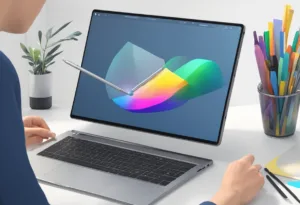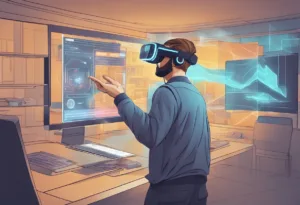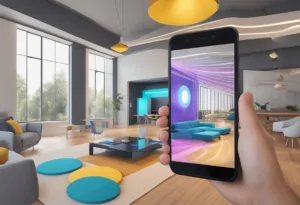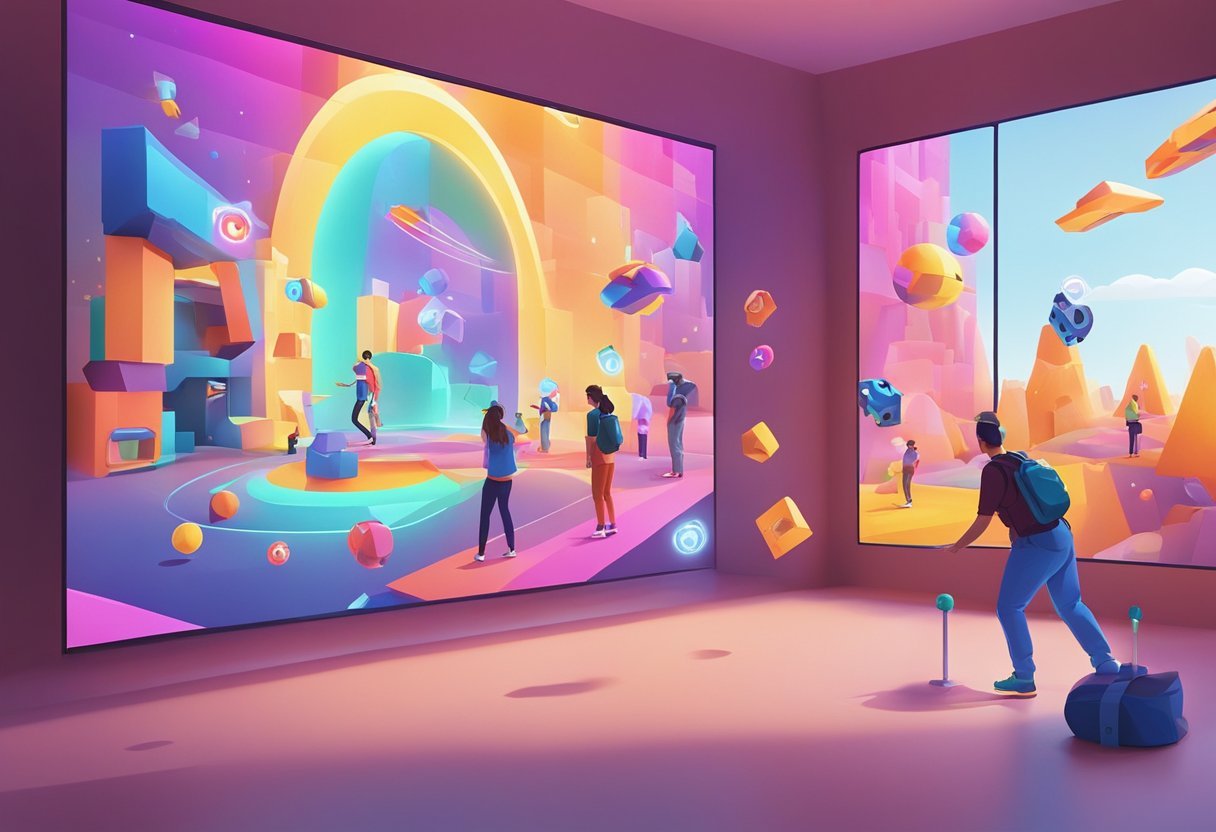Augmented Reality (AR) technology has been around for a while, but it has only recently gained popularity with the advent of immersive experiences. AR modeling is an essential aspect of AR technology, which allows users to create interactive 3D models. These models can be used for a variety of purposes, including gaming, marketing, and education. In this blog post, I will share with you 10 augmented reality modeling software and tools to help you get started.
AR modeling is a process that involves creating digital models that can be viewed in the real world using AR technology. The models can be created using a variety of software tools that allow users to create complex 3D objects. Once the models are created, they can be viewed using AR technology, which overlays the digital model onto the real world.
AR modeling has many applications, including gaming, marketing, and education. In gaming, AR modeling is used to create interactive 3D environments that allow players to immerse themselves in a virtual world. In marketing, AR modeling is used to create interactive advertising campaigns that can be viewed using AR technology. In education, AR modeling is used to create interactive learning experiences that allow students to explore complex concepts in a more engaging way.
Fundamentals of Augmented Reality Modeling
Augmented reality (AR) and virtual reality (VR) are two of the most significant advancements in technology over the last decade. AR is a technology that superimposes digital elements on the user’s real-world view, while VR immerses the user in a completely digital environment. AR and VR have numerous applications in various industries, including gaming, education, healthcare, and marketing.
AR modeling is the process of creating 3D models that can be used in AR applications. AR modeling is a complex process that involves several core technologies.
Core Technologies in AR Modeling
The core technologies used in AR modeling include 3D modeling, rendering, and real-time display. 3D modeling is the process of creating a digital representation of a physical object. In AR modeling, 3D models are used to create digital elements that can be superimposed on the user’s real-world view.
Rendering is the process of generating an image from a 3D model. In AR modeling, rendering is used to create realistic digital elements that can be superimposed on the user’s real-world view.
Real-time display is the process of displaying digital elements in real-time. In AR modeling, real-time display is used to ensure that digital elements are displayed accurately and seamlessly on the user’s real-world view.
The Role of 3D Modeling in AR
3D modeling plays a crucial role in AR modeling. The accuracy and quality of 3D models determine the quality of digital elements that can be superimposed on the user’s real-world view. 3D models used in AR modeling must be optimized for real-time display and rendering to ensure that digital elements are displayed accurately and seamlessly on the user’s real-world view.
AR modeling is a complex process that involves several core technologies, including 3D modeling, rendering, and real-time display. 3D modeling plays a crucial role in AR modeling, and the accuracy and quality of 3D models determine the quality of digital elements that can be superimposed on the user’s real-world view.
10 AR Modeling Software and Tools

Augmented Reality (AR) modeling is a rapidly growing field that requires specialized software and tools. There are several popular AR development platforms available, including Unity, AR Code Studio, and Adobe Aero. These platforms offer a range of features to help users create immersive AR experiences, from 3D modeling and animation to scripting and coding.
- Blender
- Autodesk Maya
- Autodesk 3ds Max
- SketchUp
- Cinema 4D
- ZBrush
- Tinkercad
- Substance by Adobe
- Modo
- Rhino
Blender
Blender is a free and open-source 3D creation suite that offers a wide range of tools for modeling, rendering, animation, and post-production. It is well-suited for creating detailed models for augmented reality due to its comprehensive feature set which includes advanced sculpting tools, a powerful particle system, and a fully integrated game engine.
Blender’s ability to export to multiple formats and its support for VR makes it a versatile choice for AR content creation. The software’s active community continuously contributes to its development, providing a vast array of plugins and extensions to enhance its capabilities.
Autodesk Maya
Autodesk Maya is a professional 3D software known for its powerful modeling and animation capabilities. It is widely used in the film, television, and game industries. Maya offers an extensive range of tools for creating complex animations and effects, as well as a robust set of features for simulating realistic cloth, hair, and fluids. For AR, Maya’s ability to create detailed and realistic models, along with its support for various export formats, makes it a popular choice among developers.
Autodesk 3ds Max
Autodesk 3ds Max is a 3D modeling, animation, and rendering software that provides a comprehensive set of tools for creating professional-quality 3D animations, models, and virtual reality visualizations. It is known for its strong architectural visualization capabilities and its intuitive user interface. 3ds Max’s extensive plugin architecture allows for a high degree of customization and its support for AR is bolstered by its ability to produce optimized models that are ready for real-time applications.
SketchUp
SketchUp is a 3D modeling software that is renowned for its user-friendly interface and ease of use, making it popular among architects, designers, and educators. It provides a straightforward approach to 3D design with tools that are easy to learn for beginners. SketchUp’s integration with Google Earth and its large repository of free, ready-made models available in the 3D Warehouse make it a convenient tool for creating environmental models for AR applications.
Cinema 4D
Cinema 4D is a 3D modeling, animation, and rendering application from MAXON that is appreciated for its ease of use and powerful features. It is particularly popular among motion graphics artists for its robust set of tools for creating dynamic graphics and animations. Cinema 4D’s integration with Adobe After Effects and its ability to export models in AR-compatible formats make it a valuable tool for creating AR content.
ZBrush
ZBrush is a digital sculpting tool known for its ability to create highly detailed models with its advanced brush system. It is favored for creating organic models such as characters and creatures, which can be used in AR environments. ZBrush’s features include DynaMesh for dynamic topology changes and ZRemesher for automatic retopology, allowing for high-resolution sculpting and surface detailing.
Tinkercad
Tinkercad is a free, online 3D modeling program from Autodesk that is designed for beginners. It offers a simple and intuitive interface with a set of basic shapes and tools that allow users to create 3D models quickly and easily. Tinkercad’s straightforward approach and accessibility make it a great starting point for educators and students looking to explore 3D modeling for augmented reality.
Substance by Adobe
Substance by Adobe is a suite of tools focused on texture painting and material authoring for 3D models. It includes Substance Painter for 3D painting, Substance Designer for creating custom materials, and Substance Alchemist for material management. The Substance suite is known for its high-quality textures and advanced material editing capabilities, which are essential for creating realistic models for AR.
Modo
Modo is a 3D modeling, texturing, and rendering tool known for its powerful direct modeling capabilities, photorealistic rendering, and a fully customizable user interface. It offers a range of advanced tools for creating complex geometries, realistic materials, and animations. Modo’s focus on artist-friendly workflows makes it a good option for designers and creators looking to produce 3D models for augmented reality.
Rhino
Rhino, or Rhinoceros 3D, is a 3D computer graphics and CAD application known for its mathematical precision in creating and editing curves, surfaces, and solids. It is widely used in industrial design, architecture, and jewelry design. Rhino’s ability to accurately model any shape or form makes it particularly useful for creating detailed and complex models for AR applications.
Popular AR Development Platforms
Unity is one of the most widely used AR development platforms, offering a range of features to help users create high-quality AR experiences. It is a powerful game engine that includes a range of tools for 3D modeling, animation, and scripting. Unity also supports a range of file formats, including FBX and glTF.
AR Code Studio is another popular AR development platform that simplifies the process of generating AR QR codes through an intuitive cloud-based service. It offers a range of features to help users create, convert, and export 3D files in various formats, making it an ideal choice for creating AR models.
Adobe Aero is a powerful AR development platform that allows users to create, view, and share immersive AR experiences. It offers a range of features to help users create high-quality AR models and animations, including support for 3D modeling, animation, and scripting.
3D Graphics Software for AR
In addition to AR development platforms, users will also need 3D graphics software to create high-quality AR models. Some popular options include Blender, 3ds Max, and Maya. These programs offer a range of features to help users create detailed 3D models and animations, including support for CAD and other file formats.
Blender is a free and open-source 3D graphics software that offers a range of features to help users create high-quality 3D models and animations. It includes support for a range of file formats, including FBX and glTF, making it an ideal choice for creating AR models.
3ds Max is a popular 3D graphics software that offers a range of features to help users create high-quality 3D models and animations. It includes support for a range of file formats, including FBX and glTF, making it an ideal choice for creating AR models.
Maya is a powerful 3D graphics software that offers a range of features to help users create high-quality 3D models and animations. It includes support for a range of file formats, including FBX and glTF, making it an ideal choice for creating AR models.
File Formats and Compression
When creating AR models, it is important to consider file formats and compression. Some popular file formats for AR models include FBX and glTF, which offer a range of features to help users create high-quality 3D models and animations.
Compression is also an important consideration when creating AR models, as large file sizes can cause performance issues. Some popular compression formats for AR models include JPEG and PNG, which can help reduce file sizes without sacrificing quality.
Applications of AR Modeling

Augmented Reality (AR) modeling has a wide range of applications in various industries, including education, entertainment, gaming, business, healthcare, engineering, retail, military, and manufacturing. Here are some of the most prominent applications of AR modeling:
AR in Education and Training
AR modeling has revolutionized the way education and training are delivered. AR technology enables students to explore and interact with virtual 3D models of complex concepts, making learning more engaging and interactive. AR modeling is also used in training simulations, allowing trainees to practice real-life scenarios in a safe and controlled environment.
AR in Entertainment and Gaming
AR modeling has transformed the entertainment and gaming industry by enabling users to experience immersive AR content. AR gaming involves the integration of virtual content into the real world, creating a unique and interactive gaming experience. AR modeling has also been used in creating AR experiences in theme parks and museums.
Industrial and Business Applications
AR modeling has numerous industrial and business applications, including marketing, healthcare, engineering, and retail. AR modeling is used in marketing to create interactive product demonstrations and immersive brand experiences. In healthcare, AR modeling is used in medical training and surgical simulations. In engineering, AR modeling is used in designing and prototyping products. In retail, AR modeling is used to create virtual try-on experiences and product visualizations.
AR modeling has transformed the way we interact with digital content, enabling us to experience immersive AR experiences that were once impossible. AR modeling has numerous applications across various industries, making it a valuable technology for businesses and individuals alike.
User Experience and Interaction Design
Augmented Reality (AR) modeling has opened up new possibilities for creating engaging user experiences. In order to achieve this, designers must consider various aspects of interaction design.

Creating Engaging AR Experiences
The goal of AR modeling is to create an interactive experience that enhances the user’s perception of the real world. To achieve this, designers must use a combination of visual and audio cues to create a compelling experience. AR experiences must be designed to be engaging and intuitive, allowing users to interact with virtual objects in a natural and seamless way.
Interactivity and Real-Time Feedback
Interactivity and real-time feedback are critical components of AR modeling. Users must be able to interact with virtual objects in real-time, and receive immediate feedback on their actions. This requires designers to carefully consider the user’s interactions and design the experience to respond in a natural and intuitive way.
User-Centered Design Principles
User-centered design principles are essential for creating successful AR experiences. Designers must consider the user’s needs and design the experience around their goals and expectations. This requires designers to conduct user research, create user personas, and test the experience with real users to ensure that it meets their needs.
Designing AR experiences requires careful consideration of user experience, interactions, and real-time feedback. By following user-centered design principles, designers can create engaging and intuitive experiences that enhance the user’s perception of the real world.
Trends and Future of AR Modeling

Emerging Technologies in AR
Augmented Reality (AR) is rapidly gaining popularity in various industries, including gaming, entertainment, education, and healthcare. As the technology evolves, new trends emerge, and existing ones continue to grow. One of the emerging trends in AR modeling is the use of digital twins. A digital twin is a virtual representation of a physical object, machine, or system. It allows designers and engineers to simulate and optimize the performance of a product in a virtual environment before it is built.
Another emerging technology in AR modeling is machine learning. Machine learning algorithms can analyze large amounts of data and identify patterns that humans may not be able to see. This technology can help designers and engineers create more accurate and efficient models.
The Convergence of AR and AI
The convergence of AR and Artificial Intelligence (AI) is another trend in AR modeling. AI-powered AR applications can provide users with personalized and context-aware experiences. For example, an AR application can use computer vision and natural language processing to identify objects in the real world and provide users with relevant information.
AR’s Role in the Metaverse
AR modeling is also expected to play a significant role in the development of the Metaverse. The Metaverse is a virtual world that is fully immersive and interactive. It is a place where users can interact with each other and with virtual objects in a seamless way. AR technology can help create a more immersive and interactive experience in the Metaverse by overlaying virtual objects onto the real world.
AR modeling is a rapidly evolving field with many emerging trends. Digital twins, machine learning, and the convergence of AR and AI are just a few of the technologies that are shaping the future of AR modeling. AR’s role in the development of the Metaverse is expected to be significant. As the technology continues to evolve, AR modeling is likely to become even more prevalent in various industries.
Frequently Asked Questions
What software is used for creating augmented reality models?
There are several software applications that can be used for creating augmented reality models. Some of the popular ones include Unity, Vuforia, ARToolKit, and ARCore. These software applications provide a range of tools and features that help developers create AR models, including 3D modeling, animation, and texturing.
Which platforms support the integration of AR models?
AR models can be integrated into a range of platforms, including mobile devices, tablets, and smart glasses. Some of the popular platforms that support AR models include iOS, Android, and Windows. These platforms provide a range of tools and features that enable developers to create AR experiences that are immersive and engaging.
What are the steps involved in developing an AR model?
The process of developing an AR model involves several steps, including ideation, 3D modeling, animation, texturing, and integration. The first step is to come up with an idea for the AR model. Once the idea is finalized, the next step is to create a 3D model of the object or environment. After the 3D model is created, it is animated and textured to make it look realistic. Finally, the AR model is integrated into the platform or application where it will be used.
Can you list some examples where AR modeling has been effectively implemented?
AR modeling has been effectively implemented in several industries, including gaming, education, and healthcare. In the gaming industry, AR models have been used to create immersive and engaging games that provide a unique user experience.
In the education industry, AR models have been used to create interactive learning experiences that help students understand complex concepts. In the healthcare industry, AR models have been used to create simulations that help medical professionals train and prepare for complex procedures.
What are the key features that define a robust AR modeling experience?
A robust AR modeling experience should be immersive, interactive, and engaging. The AR model should be designed in a way that makes it easy for users to interact with it and explore its features. The model should also be designed to be visually appealing and realistic, with high-quality textures and animations. The AR model should be integrated into the platform or application in a way that provides a seamless user experience.
How can one access or view 3D models in an augmented reality environment?
Users can access or view 3D models in an augmented reality environment by using a compatible device or application. Some of the popular devices and applications that support AR models include smartphones, tablets, and smart glasses. Users can also use AR-enabled browsers to view 3D models in an augmented reality environment. Once the user has access to the AR environment, they can interact with the 3D model by using gestures or voice commands.




